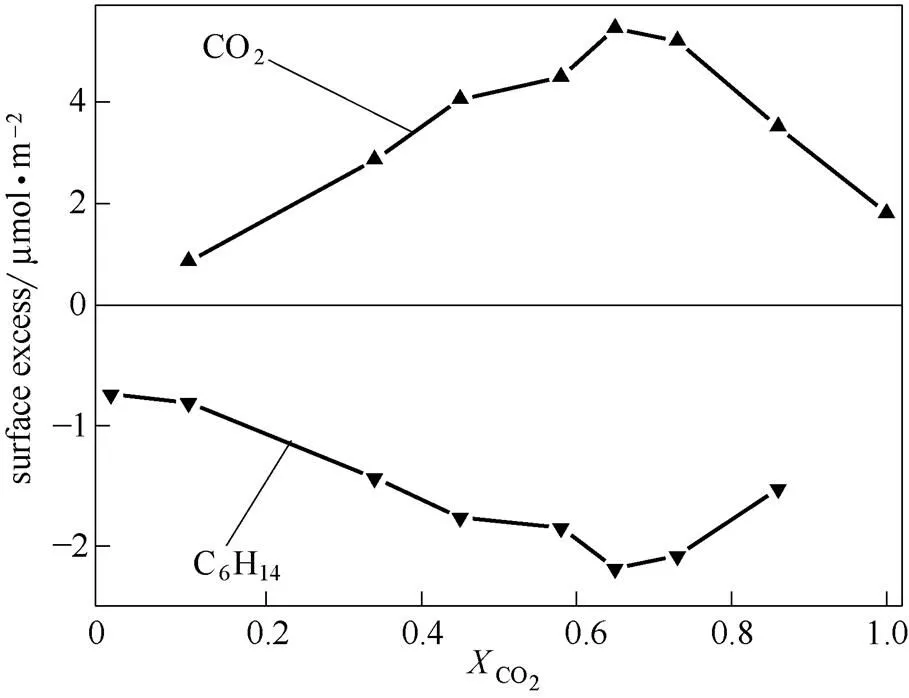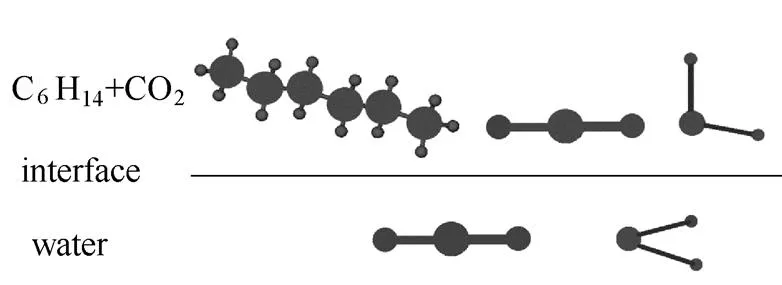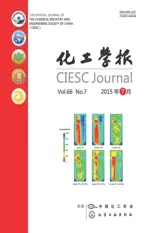CO2浓度对混溶态(CO2+正己烷)/盐水界面微观特性的影响
2015-10-15陶璐赵伶玲王镜凡
陶璐,赵伶玲,王镜凡
CO2浓度对混溶态(CO2+正己烷)/盐水界面微观特性的影响
陶璐,赵伶玲,王镜凡
(东南大学能源与环境学院,能源热转换及其过程测控教育部重点实验室,江苏南京 210096)
在CO2以超临界状态封存于油气藏时,储层中流体间的界面性质是影响封存效率和封存量的重要因素。利用分子动力学模拟的方法,对330 K、20 MPa混溶条件下(CO2+正己烷)/NaCl溶液系统的界面微观性质进行了研究,分析了混溶相中CO2摩尔分数变化时,界面处CO2和正己烷的亲水、疏水特性及其影响,为CO2地质封存提供理论依据。研究发现,随着混溶相中CO2摩尔分数的增加,界面厚度及粗糙度增大,分子渗透加深,热波动加剧。界面上CO2与水之间更强的相互作用造成了CO2注入过程中界面张力的降低。CO2表现出类似于表面活性剂的性质,并在CO2摩尔分数为65%(质量分数为50%)时,其界面累积量以及正己烷的驱离量最大。界面处存在特殊的分子微观结构,CO2、水及正己烷分子呈现特殊的排布方式。
超临界CO2;CO2地质封存;界面;分子模拟
引 言
CO2地质封存为减缓全球气候变暖的有效途径,其在油气藏中的储存还可提高石油采收率,因此得到广泛的关注与研究[1-2]。为了提高经济性,这些油气藏中通常先通过注水进行驱油[3]。因此储层中通常存在CO2、原油及盐水的综合流体系统。注入的CO2一般处于超临界状态,当储层压力大于最小混溶压力时,CO2与原油形成混溶现象[4],共同与盐水形成界面。
在将CO2注入储层时,其与储层内流体间的界面张力(interfacial tension,IFT)直接决定了CO2的注入能耗及最大存储量,并控制着毛细管密封效率和地质中的运输特性[3],因此,CO2与储层内流体间的界面特性对CO2封存过程有重要影响。当CO2封存于油气藏时,在CO2与原油达到混溶后,两者之间的IFT值几乎为零[5]。CO2-原油-盐水系统在混溶压力下的IFT主要由CO2-原油混溶相与盐水间的相互作用所致。实验发现,相同环境条件下CO2-原油-盐水系统的IFT随着混溶相中CO2摩尔分数增加而降低[6]。CO2在原油中的溶解易改变界面性质,但详细的行为及影响规律未见报道。
分子动力学模拟(molecular dynamic simulation,MD模拟)近年来受到广泛的关注。目前在CO2-流体界面性质的MD模拟方面已有相关的研究。da Rocha 等[7]模拟了CO2-水系统,发现其界面上存在毛细波纹,并且较大的界面厚度会引起IFT的降低。在CO2-盐水系统中,CO2会在界面附近产生累积[8]。界面处CO2倾向于与界面平行排布,水分子也呈现出特殊的排布倾向[9]。关于CO2、石油和盐水界面的MD模拟还有待研究。
本文应用MD模拟的方法,以结构较简单、具有烷烃性质的正己烷(-C6H14)为例,进行了三相界面系统的初步探究。具体研究了混溶条件下CO2-正己烷-NaCl溶液系统的界面微观性质,分析了界面厚度及粗糙度、CO2和正己烷的界面过余量等参数随CO2摩尔分数的变化规律,预测了界面微观结构中各物质的分布形态。探究各物质尤其是CO2的行为及其对界面性质如IFT的影响及原因,为CO2-原油-盐水储层系统及CO2的地质储存提供微观理论支持。
1 研究对象及方法
1.1 对象及模型
本文的研究对象为在典型混溶储层条件330 K和20 MPa下,CO2、正己烷混溶相中CO2摩尔分数变化的(CO2+正己烷)/NaCl溶液界面系统。计算中考虑了分子间非键结作用及分子内键结作用。分子间的非键结作用包括范德华力和库仑静电力。对范德华力采用兰纳-琼斯势能函数[10]进行模拟,分子间库仑静电力采用库仑定律表示。分子内的键结作用包括键拉伸和键角弯曲,分别采用谐波势能函数[8]进行模拟。
各分子中原子的质量、电荷及势能阱深度等参数从相关的力场模型中选取。正己烷分子应用OPLA-AA[11]力场进行模拟,水分子选择柔性的F3C模型[12],CO2选择柔性的EPM2模型[13]。盐离子采用Chandrasekhar等[14]开发的力场。
1.2 系统建模
应用MD软件Gromacs4.5[15]进行计算。以CO2、正己烷混溶相中CO2摩尔分数0.73为例,所建立的计算域为4 nm×4 nm×16 nm,示于图1。计算域中部为NaCl盐水,包括2080个水分子,50个Na+和50个Cl-,对应盐度为1.89 mol·L-1。右侧为241个正己烷分子,左侧为CO2,其分子个数根据的取值来确定。应用周期性边界条件,利用Berendsen方法[16-17]设定温度及压力。采用PME技术模拟分子间长程库仑作用力,范德华作用截距设定为0.9 nm[18]。时间步长设为1 fs,在NPzT系统条件下运行30 ns。在15 ns时观测到系统平衡,采集25~30 ns的模拟结果进行数据处理和分析。

图1 CO2-正己烷-NaCl溶液系统初始状态及平衡状态的对比(0.73)

1.3 数据处理
采用25~30 ns的模拟结果进行数据处理。界面张力定义为界面上正向(方向)和侧向(和方向)压力张量分量的差异[19]。因系统包括两个界面,可表示为

式中,P、P、P分别为沿、、方向压力张量对向的角分量;L为系统沿轴方向的长度。
Gibbs分界面(Gibbs dividing surface,GDS)以体相为参照,其位置取界面处CO2侧水分子的过剩量与水侧水分子的缺乏量相等的轴坐标值;GDS界面厚度采用0.1~0.9倍水密度之间的距离[20]表示。界面过余量表征物质在界面和体相中分布的差异,如CO2-C6H14-NaCl溶液界面上分量的界面过余量可用式(2)表示

2 结果与讨论

图2 IFT模拟值、实验值及GDS厚度随的变化

图3 0.73时界面处各物质沿z轴密度分布
2.1 界面厚度及粗糙度
界面厚度反映了分子渗透深度和热波动产生毛细波纹的规律,Culcer等[22]用界面粗糙度来对此现象进行表征。当为0、0.34、0.65、1时,对30 ns瞬时的界面NaCl溶液侧利用分子可视化软件VMD[23]中的QuickSurf方法进行表面模化,结果示于图4。较光滑的区域为趋于溶液体相的水分子位置,而凹凸不平的突起则表示界面处向混溶相渗透的水分子位置分布。通过比较发现,随着增加,溶液侧表面的突起分布逐渐变广,界面越来越复杂,粗糙度增大。这说明当更多CO2分子与正己烷混溶时,界面上分子渗透加深,并且热波动产生的毛细波纹波长更短。CO2分子结构简单,可以与水部分混溶,但正己烷则因多CH键的复杂结构与水完全不能相溶,因此CO2与正己烷相比具有亲水性。当增加时,界面上CO2分子数目增多,其与水分子形成了较强的相互作用,分子渗透更深,热波动加剧,引起界面厚度的增加,并导致了CO2注入过程中储层内部IFT降低的现象。

图4 部分系统界面溶液侧的表面模化结果
2.2 界面过余量
CO2及正己烷界面过余量随的变化曲线示于图5。计算所得为正值,为负值,即CO2在GDS界面累积,C6H14在界面驱离。由图5可知,在<0.65时,及()都随着增加而增加;在0.65时,和分别达到正向及负向极值;在>0.65时,及()则随着增大呈降低趋势。

图5 CO2及正己烷的界面过余量随的变化曲线

图6 各系统CO2及正己烷密度沿z轴分布情况
2.3 界面分子分布形态
通过对界面内分子取向的概率统计,各物质在界面处都呈现出特殊的排布方式。为更直观地观察分子结构,GDS处各分子的取向倾向如图7所示。水分子在GDS水侧倾向于与界面平行排列,在CO2+C6H14侧则倾向于将OH键朝着CO2+C6H14混溶相;CO2分子倾向于与界面平行排列;C6H14分子最长的主轴倾向于与界面法向呈60°夹角排列,接近于与界面平行分布。

图7 界面上各分子分布倾向示意图
● H; ● O; ● C
界面处特殊的分子排布方式影响着界面相互作用。CO2分子与界面相平行的排列方式不仅降低了对水分子间相互作用的影响,也最大程度地促进了CO2与水分子间的作用[24]。此外,还有可能形成了特殊的CO2-H2O界面水合物[25],对界面张力产生影响。同理,正己烷分子在界面处也形成了接近平行分布的排列方式。水分子与其他相接触时,为促进氢键的形成,水分子产生了明显的取向倾向[26]。但界面相互作用与分子形态之间的相互联系,以及CO2浓度变化时界面微观结构的变化及影响还有待进一步研究。
3 结 论
本文采用MD模拟的方法对330 K和20 MPa下CO2-正己烷-NaCl溶液系统进行了界面微观性质的研究,分析了CO2+正己烷混溶相中CO2的摩尔分数改变时,界面厚度及粗糙度、物质的界面过余量等的变化规律,并预测界面微观结构中各物质的分布形态,可为理解CO2地质储存时储层内的界面微观结构提供理论依据。结论如下。
(3)界面处存在特殊的分子微观结构,CO2、水及正己烷分子呈现特殊的排布倾向规律,与界面相互作用间存在一定联系。
符 号 说 明

,——分别为i物质在A相和B相中的浓度,mol·L-1 Lz——系统沿z轴的长度,nm ——i物质在系统中的总物质的量,mol Pxx,Pyy,Pzz——分别为沿x、y、z方向压力张量对z向的角分量,Pa S——系统沿z向横截面面积,m2 ——CO2、C6H14中CO2的摩尔分数 ——i物质的界面过余量,μmol·m-2 ——界面张力,mN·m-1
References
[1] Wan X, Song Y, Zhang Y, Nishio M, Zhan Y, Jian W, Shen Y. Research progress of the interfacial tension in supercritical CO2-water/oil system [J]., 2013, 37: 6928-6935.
[2] Liu Chang (刘畅), Lu Xiaohua (陆小华). Carbon reduction pattern in China: comparison of CCS and biomethane route [J].(化工学报), 2013, 64 (1): 7-10.
[3] Ameri A, Kaveh N S, Rudolph E S J, Wolf K H, Farajzadeh R, Bruining J. Investigation on interfacial interactions among crude oil-brine-sandstone rock-CO2by contact angle measurements [J]., 2013, 27: 1015-1025.
[4] Wang X, Gu Y. Oil recovery and permeability reduction of a tight sandstone reservoir in immiscible and miscible CO2flooding processes [J]....., 2011, 50:2388-2399.
[5] Rao D N, Lee J I. Determination of gas-oil miscibility conditions by interfacial tension measurements [J]..., 2003, 262 (2): 474-82.
[6] Sun C, Chen G. Measurement of interfacial tension for the CO2injected crude oil + reservoir water system [J]...., 2005, 50: 936-938.
[7] Sandro R P da Rocha, Keith P Johnson. Molecular structure of the water-supercritical CO2interface [J]...., 2001, 105: 12092-12104.
[8] Li X, Ross D A, Trusler J P M, Maitland G C, Boek E S. Molecular dynamics simulations of CO2and brine interfacial tension at high temperatures and pressures [J]...., 2013, 117: 5647-5652.
[9] Zhao L, Lin S, Mendenhall J D, Yuet P K, Blankschtein D. Molecular dynamics investigation of the various atomic force contributions to the interfacial tension at the supercritical CO2-water interface [J]...., 2011, 115: 6076-6087.
[10] Fan Kangnian (范康年). Physical Chemistry (物理化学) [M]. 2nd ed. Beijing: Higher Education Press, 2005: 222.
[11] Kaminski G A, Friesner R A, Tirado-Rives J, Jorgensen W L. Evaluation and reparametrization of the OPLS-AA force field for proteinscomparison with accurate quantum chemical calculations on peptides [J]...., 2001, 105: 6474-6487.
[12] Levitt M, Hirshberg M, Sharon R, Laidig K E, Daggett V. Calibration and testing of a water model for simulation of the molecular dynamics of proteins and nucleic acids in solution [J]...., 1997, 101 (25): 5051-5061.
[13] Nieto-Draghi C, de Bruin T, Perez-Pellitero J, Avalos J B, Mackie A D. Thermodynamic and transport properties of carbon dioxide from molecular simulation [J]...., 2007, 126 (6): 064509.
[14] Chandrasekhar J, Spellmeyer D C, Jorgensen W L. Energy component analysis for dilute aqueous-solutions of Li+, Na+, F-, and Cl-ions [J]....., 1984, 106 (4): 903-910.
[15] Pronk S, Pall S, Schulz R, Larsson P, Bjelkmar P, Apostolov R, Shirts M R, Smith J C, Kasson P M, van der Spoel D, Hess B, Lindahl E. GROMACS 4.5: a high-throughput and highly parallel open source molecular simulation toolkit [J].,2013, 29: 845-854.
[16] Berendsen H J C, Postma J P M, Dinola A, Haak J R. Molecular dynamics with coupling to an external bath [J]...., 1984, 81: 3684-3690.
[17] Bussi G, Donadio D, Parrinello M. Canonical sampling through velocity rescaling [J]...., 2007, 126 (1): 014101.
[18] Ismail A E, Grest G S, Stevens M.J. Capillary waves at the liquid-vapor interface and the surface tension of water [J]...., 2006, 125 (1): 014702.
[19] Alejandre J, Tildesley D J, Chapela G A. Molecular-dynamics simulation of the orthobaric densities and surface-tension of water [J]...., 1995, 102 (11): 4574-4583.
[20] Yuet P K, Blankschtein D. Molecular dynamics simulation study of water surfaces: comparison of flexible water models [J]...., 2010, 114 (43): 13786-13795.
[21] Kumagai A, Tomida D, Yokoyama C. Measurements of the liquid viscosities of mixtures of-butane,-hexane, and-octane with squalane to 30 MPa [J]..., 2006, 27: 376-393.
[22] Culcer D, Hu Xuedong , Sarma S D. Interface roughness, valley-orbit coupling, and valley manipulation in quantum dots [J]..., 2010, 82 (20): 205315.
[23] Humphrey W, Dalke A, Schulten K. VMD: visual molecular dynamics [J]...,1996, 14 (1): 33-38.
[24] Marcos E P B, Edward M J. Molecular dynamics simulations of CO2at an ionic liquid interface: adsorption, ordering, and interfacial crossing [J]...., 2010, 114 (36): 11827-11837.
[25] Tewes F, Boury F. Thermodynamic and dynamic interfacial properties of binary carbon dioxide-water systems [J]...., 2004, 108: 2405-2412.
[26] Fan Y, Chen X, Yang L, Cremer P S, Gao Y. On the structure of water at the aqueous/air interface [J]...., 2009, 113 (34): 11672-11679.
Influence of CO2fraction on micro interfacial properties of miscible (CO2+-hexane)/NaCl interface
TAO Lu, ZHAO Lingling, WANG Jingfan
(Key Laboratory of Energy Thermal Conversion and Control of Ministry of Education, School of Energy and Environment, Southeast University, Nanjing 210096, Jiangsu, China)
In the geological carbon dioxide (CO2) sequestration in abandoned oil reservoirs, there usually exists a fluid system including CO2, oil and brine, where the interplay between them is very important for the successful CO2storage. In this paper, molecular dynamics simulations were carried out to investigate the interfacial characteristics of the CO2,-hexane and NaCl solution system with different CO2fractions at the miscible state. CO2and-hexane formed a miscible phase, and a clear interface was observed to separate the CO2and-hexane mixture with brine. Both the interfacial width and roughness increased with increasing CO2composition, indicating the stronger interfacial interactions when water molecules contacted with CO2, leading to the reduction of interfacial tension. The surface adsorption of CO2reached the maximum when CO2molar fraction equaled to 65%, as well as the deficiency of-hexane. This implied the surfactant feature of CO2and the hydrophobicity of-hexane towards the interface investigated. A special micro structure was observed at the interface, where CO2, water and-hexane molecules had own preferred arrangement tendency. The special interfacial characteristics found could explain the experimental IFT phenomena and the microstructure variation in the CO2injecting process, and could provide some theoretical guidance for CO2sequestration.
supercritical carbon dioxide; CO2geological storage; interface; molecular simulation
2015-01-21.
supported by the National Natural Science Foundation of China (51106027).
ZHAO Lingling, zhao_lingling@seu.edu.cn
10.11949/j.issn.0438-1157.20150104
TQ 021.2
A
0438—1157(2015)07—2601—06
国家自然科学基金项目(51106027)。
2015-01-21收到初稿,2015-03-30收到修改稿。
联系人:赵伶玲。第一作者:陶璐(1990—),女,硕士研究生。
